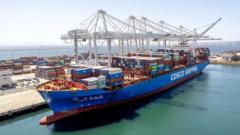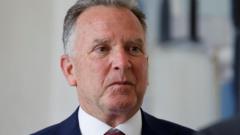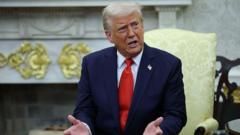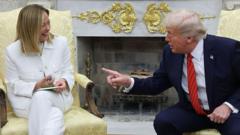Amid significant market turmoil prompted by higher tariffs, President Trump has paused tariffs on various nations for 90 days but has escalated tariffs against China to 125%. This shift comes as the U.S. grapples with major economic impacts and diplomatic tensions.
Trump Adjusts Tariffs in Response to Market Fluctuations, Escalates Against China
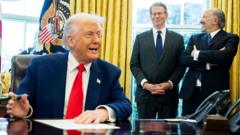
Trump Adjusts Tariffs in Response to Market Fluctuations, Escalates Against China
President Trump announces a temporary pause on tariffs for most countries while intensifying sanctions on China, triggering a wave of reactions amidst economic uncertainty.
Article:
In a bold shift in trade policy, President Donald Trump has declared a 90-day cessation on the implementation of higher tariffs for a majority of U.S. trading partners, notwithstanding a marked escalation in tariffs against China. This announcement comes shortly after the initiation of levies affecting approximately 60 nations, mainly inspired by concerns over trade practices that Trump deems unfair.
In a surprising move, Trump authorized a universal "lowered reciprocal tariff" of 10% while also intensifying tariffs on Chinese imports to a staggering 125%. Trump's accusations against China include fostering a "lack of respect" when it retaliated with a series of tariffs amounting to 84% on U.S. goods. This rapid exchange of tariff intensifications has sparked fears of a looming global trade war, evoking nightmares of recession as analysts project potential economic fallout.
Market responses have been swift and dramatic. Following last week's foreboding announcements that resulted in significant market sell-offs—erasing trillions in global value—Trump's latest tariff revisions led to a remarkable recovery in U.S. stocks. The S&P 500 surged by 7% in late trading, while the Dow Jones experienced a steep climb of 7.8%. Just prior to that, interest rates on U.S. government debt had spiked to a 4.5% yield, reflecting the anxiety permeating financial markets.
Trump revealed his overnight motivations via social media, indicating that he believed a pause was necessary for countries that had shown restraint. On the contrary, he perceived China's retaliatory tariffs as a cue to double down on punitive measures, promising an uncompromising stance in the negotiations. Trump's confidence in achieving a “great deal” with Chinese President Xi Jinping contrasted with global skepticism regarding such outcomes.
In the aftermath of Trump's tariff revisions, which did not affect the baseline 10% on the UK—already designated a "worst offender"—one spokesperson for the British government expressed relief, acknowledging that a trade war benefits no country.
The U.S.-China trade discord has deepened, following recent tariffs imposed by Beijing, which had already been escalated in response to U.S. measures. As a result, U.S. goods transported to China faced a barrage of rising tariffs, fueling mutual hostility that could threaten an estimated $466 billion drop in bilateral trade. The situation has elicited pointed reactions from both sides, with Chinese officials urging an end to what they deem "bullying practices" in favor of respectful negotiations.
As Trump pursues his protective tariff approach, other existing tariffs remain in force, including 25% on steel and car parts entering the U.S. Additionally, the European Union has begun preparations for retaliatory measures against the U.S., further complicating an already tumultuous trade landscape.
In a bold shift in trade policy, President Donald Trump has declared a 90-day cessation on the implementation of higher tariffs for a majority of U.S. trading partners, notwithstanding a marked escalation in tariffs against China. This announcement comes shortly after the initiation of levies affecting approximately 60 nations, mainly inspired by concerns over trade practices that Trump deems unfair.
In a surprising move, Trump authorized a universal "lowered reciprocal tariff" of 10% while also intensifying tariffs on Chinese imports to a staggering 125%. Trump's accusations against China include fostering a "lack of respect" when it retaliated with a series of tariffs amounting to 84% on U.S. goods. This rapid exchange of tariff intensifications has sparked fears of a looming global trade war, evoking nightmares of recession as analysts project potential economic fallout.
Market responses have been swift and dramatic. Following last week's foreboding announcements that resulted in significant market sell-offs—erasing trillions in global value—Trump's latest tariff revisions led to a remarkable recovery in U.S. stocks. The S&P 500 surged by 7% in late trading, while the Dow Jones experienced a steep climb of 7.8%. Just prior to that, interest rates on U.S. government debt had spiked to a 4.5% yield, reflecting the anxiety permeating financial markets.
Trump revealed his overnight motivations via social media, indicating that he believed a pause was necessary for countries that had shown restraint. On the contrary, he perceived China's retaliatory tariffs as a cue to double down on punitive measures, promising an uncompromising stance in the negotiations. Trump's confidence in achieving a “great deal” with Chinese President Xi Jinping contrasted with global skepticism regarding such outcomes.
In the aftermath of Trump's tariff revisions, which did not affect the baseline 10% on the UK—already designated a "worst offender"—one spokesperson for the British government expressed relief, acknowledging that a trade war benefits no country.
The U.S.-China trade discord has deepened, following recent tariffs imposed by Beijing, which had already been escalated in response to U.S. measures. As a result, U.S. goods transported to China faced a barrage of rising tariffs, fueling mutual hostility that could threaten an estimated $466 billion drop in bilateral trade. The situation has elicited pointed reactions from both sides, with Chinese officials urging an end to what they deem "bullying practices" in favor of respectful negotiations.
As Trump pursues his protective tariff approach, other existing tariffs remain in force, including 25% on steel and car parts entering the U.S. Additionally, the European Union has begun preparations for retaliatory measures against the U.S., further complicating an already tumultuous trade landscape.


